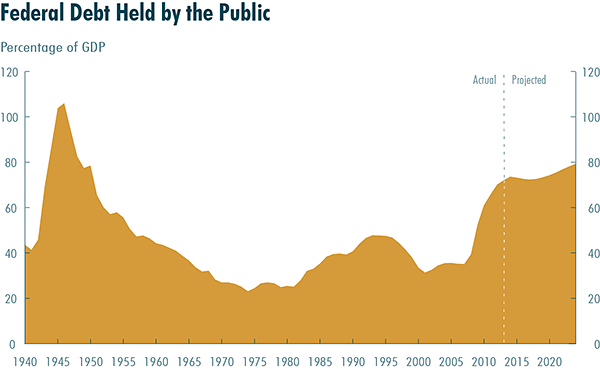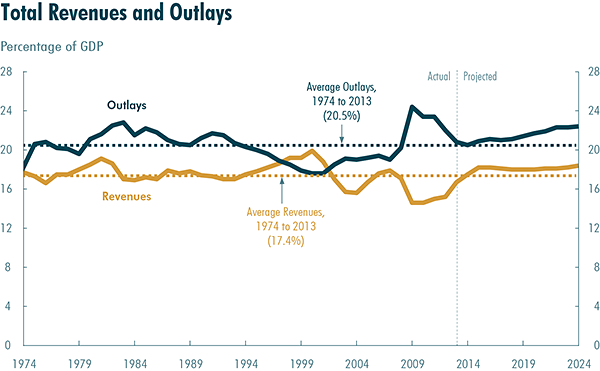Here is a link to the recently released document:
- The Budget and Economic Outlook: 2014 to 2024
Here the two key graphs in the report:


Here's what they have to say about projected revenues:
Federal revenues are expected to grow by about 9 percent this year, to $3.0 trillion, or 17.5 percent of GDP—just above their average percentage of the past 40 years (see the figure below). Revenues were well below that average in recent years, both because the income of individuals and corporations fell during the recession and because policymakers reduced some taxes. The expiration of various tax provisions and the improving economy underlie CBO’s projection that revenues will rise sharply this year. Those factors will increase revenues further in 2015, with CBO’s baseline showing another 9 percent rise. After 2015, revenues are projected to grow at about the same pace as output and to average 18.1 percent of GDP under the current-law assumptions of CBO’s baseline.
And here's what they have to say about projected spending:
Federal outlays are expected to increase by 2.6 percent this year, to $3.5 trillion, or 20.5 percent of GDP—their average percentage over the past 40 years. CBO projects that under current law, outlays will grow faster than the economy during the next decade and will equal 22.4 percent of GDP in 2024. With no changes in the applicable laws, spending for Social Security, Medicare (including offsetting receipts), Medicaid, the Children’s Health Insurance Program, and subsidies for health insurance purchased through exchanges will rise from 9.7 percent of GDP in 2014 to 11.7 percent in 2024, CBO estimates. Net interest payments by the federal government are also projected to grow rapidly, climbing from 1.3 percent of GDP in 2014 to 3.3 percent in 2024, mostly because of the return of interest rates to more typical levels. However, the rest of the government’s noninterest spending—for defense, benefit programs other than those mentioned above, and all other nondefense activities—is projected to drop from 9.4 percent of GDP this year to 7.3 percent in 2024 under current law.
The report contains some controversial predictions about the impact of the ACA on the number of jobs in the economy. It argues that a variety of responses to the law's requirements will lead to a reduction of over 2 million jobs by 2012. The White House and congressional Republicans are arguing over what this means for the laws merits.
- see this Washington Post story for greater detail.